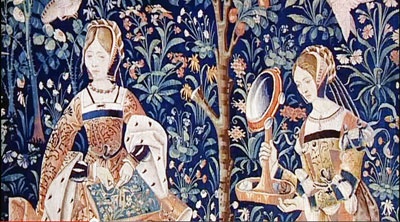You might wonder what pins (as in, sewing pins) and woad have in common. And I wonder the same thing! According to Tony Robinson, making pins and dyeing with woad are two of the worst jobs in history. Following up on yesterday’s post on dyeing wool threads with woad, I started squizzing around the internet and found some interesting information. But by far the most interesting – and entertaining – are a couple clips from Tony Robinson’s series, The Worst Jobs in History. So I thought I’d point these out to you, in case you haven’t seen them, to give a little more insight into the dyeing of wool with woad.

The dyer in Robinson’s video asserts that the blue from woad is one of the most brilliant colors remaining in textile collections from the medieval & Tudor ages. He attributes this to the properties of woad dyeing. Not only is the exposé on the job interesting, it’s also entertaining in a completely “Tony Robinson” way.
There are two clips that are of interest here, and the actual part about dyeing with woad doesn’t come in until about 5:13 on the first clip. However, those first five minutes of the first clip might be of interest to anyone who uses pins today. Robinson explores pin making in Tudor times, which should give you a whole new appreciation for The Pin.
The woad excerpt continues into the second clip, which is when you get to see the wool go from a rather wretched greenish yellow to a rich blue in just a matter of seconds. (Daily Newsletter Readers may have to visit today’s article on Needle ‘n Thread to view the videos, if they don’t show up in your e-mail).
Part One on Woad (starts at about 5:13)
Part Two on Woad (plus other stuff)
A few more points on woad, since so many folks expressed interest in it. Before you decide to replant your vegetable garden with woad and become a woad dyer on your free weekends, check with your local agricultural department. Woad is listed as a noxious plant in many states, and it’s actually prohibited in some. It’s an invasive “weed” and very aggressive. So you’ll want to find out a bit about it before you decide to plant heaps of it in your backyard. But curiously enough, woad is also being extensively studied right now for health benefits. Apparently, in China, woad root has been used for centuries to help with all kinds of ailments, and apparently woad has certain properties that may be helpful in fighting cancer. It’s an interesting plant to read about, with an interesting history.
I hope you enjoy these little video clips!
Tomorrow, thanks to Andie at Renaissance Dyeing, we’ll have a little crewel thread give-away of the woad range:

Look for it!







Mary you must have read my mind, I was also researching woad…to plant in my garden, ha!
Of coarse a little invasive “weed” doesn’t scare me, my garden is full of them!
Thank you for the information, very interesting,
Danielle
Thanks so much for the video clips on dying with woad. I really learned a great deal and being able to actually see the wool turn blue was magical!
Best wishes,
Linda
Mary, you’re the coolest! Great information for the curious ones in blogland.
BTW, checked the EGA schedule of classes for next year. Will you ever consider offering up a class or two on the National Seminar level? Maybe 2013 or so? How does that work anyway? Do you have to be invited, or do you submit a class offering and get picked?
Thank you for all the woad info. It was truly fascinating, and the videos were great. Very educational, informative, AND fun!
Thank you for that. Very interesting!
WOW Mary that was so interesting, I love learning about how things were made in early times, 🙂
Thanks for these videos Mary, gosh I am pleased that pins are machine made now and that I don’t have to use things made by poorly paid workers in horrible conditions.
And the poor old fishwives, just another example of patriarchal societies not liking strong-minded women. Long live women’s lib!
Very interesting reading!!!
This was so interesting – thanks for sharing.
Thank you so much Mary, So lovely to see the late and great John Edmonds who did so much for natural dyeing and woad dyeing in particular. I used to think that the woad plant was pretty safe as far as invasion was concerned if one gathered all the flowers before they seeded but this last year I have been gathering woad from plants that have sprung up from old roots left in the ground. On the other hand a few years back there was an enormous woad field near here and today there is not one plant growing there not even in the hedgerows. I should add that fresh woad doesn’t smell quite so strong as the old fermented woad balls although it is smellier than indigo without a doubt. Luckily I don’t use woad everyday so I hope I am not a human Stilton. I will have to ask my friends!